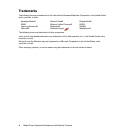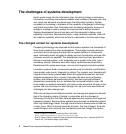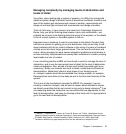
2 Model Driven Systems Development with Rational Products
The challenges of systems development
As the world moves into the Information Age, the rate of change is increasing.
Information is enabling new business models, such as eBay or Amazon.com, and
as a result new demands are placed upon the information systems. System
complexity is increasing in response to the capability of languages, technology,
and global information flow. Coincident with increasing complexity, the pace of
change is creating a need to reduce the time required to deliver solutions.
Systems development has not kept pace with the demands to deliver more
capability in less time. Development teams, using traditional methods, often still
fail to deliver capability, which can be fatal to a business in the Information Age.
The changed context for systems development
Computing technology has advanced so that modern systems are thousands of
times more powerful than their predecessors. This change removed resource
constraints and is changing the approach to system delivery in fundamental
ways. Historically teams struggled to deploy as much functionality using as little
computer resource as possible. The development team's primary goal was to
delivery a working system—cost, especially over a system's life cycle, was a
secondary solution. Solutions were often highly customized and proprietary.
Development life cycles were longer, and we could regularly schedule updates.
In modern systems, fewer components provide more functionality and therefore
have greater code counts. Integration is critical. Our systems must integrate with
today and tomorrow's systems now. Within the systems themselves, we must
integrate components from a variety of sources. We have many technology
choices, and software permeates everything. We have improved software
development productivity, but our software has increased tenfold in size
2
. We
must update our systems constantly, yet reduce costs across the life span of the
system. We must innovate, but also manage risk; we must meet new technical
challenges, but also manage cost.
Within the aerospace and defense markets, the changes are especially dramatic
due to the changing nature of threats in conjunction with the changes to
technology. During the Cold War, defense agencies and suppliers built large and
expensive systems. Because these systems were focused on defending against
other high technology threats, the high cost and time to develop was not seen as
a major issue. With the threats posed by terrorism, this has changed. Terrorists
cause disruption with relatively low cost devices and also change their tactics
2
David Longstreet, Software Productivity Since 1970, 2002
(http://www.softwaremetrics.com/Articles/history.htm).
cited in Cantor, Rational Unified Process for Systems Engineering, Part 1: Introducing RUP SE
Version 2.0, The Rational Edge, August 2003


















